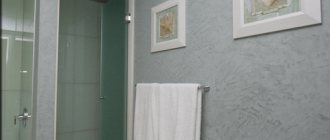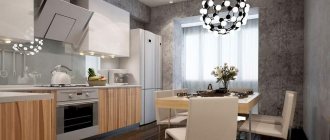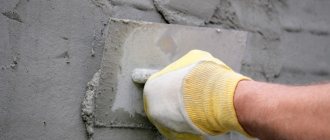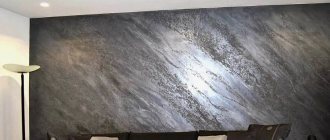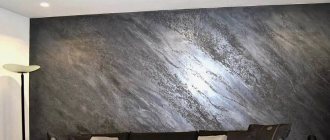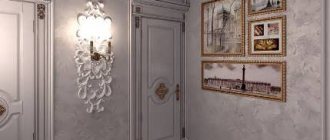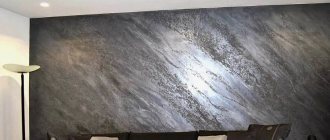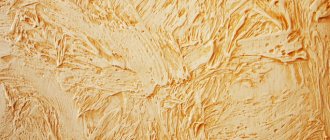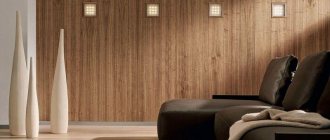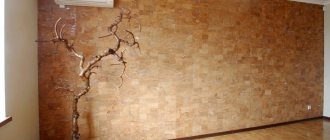Criteria for choosing a wall finishing method
Decorative plaster or paintable wallpaper - which is better? When answering this difficult question, you need to understand by what criteria a preliminary assessment of a particular material is carried out. The main criteria are:
- Durability of the selected coating.
- Price.
- Ease of use.
In terms of durability, wallpaper is inferior to the mixture. The prospect of re-pasting failed wallpaper is more likely than re-treating the walls with a competing composition.
Considering the pricing policy of the two materials, one must agree that wallpapers are much cheaper, although when choosing them you can encounter a high price.
For example, photo wallpaper, fabric or paintable wallpaper. The minimum price of plaster starts from 200 rubles. And the lowest cost of wallpaper does not exceed 50 rubles.
When performing repairs yourself, ease of use plays an important role. After all, it is easier to cover walls with wallpaper than to plaster the walls.
Durability
Any person carrying out repairs wants to receive a high-quality product that will be pleasing to the eye and will last a long time. For example, rare wallpaper will last about 5 years. Non-woven wallpaper will retain its beauty for 10 years. And only fiberglass materials can be used for up to 20 years. The service life of decorative mixtures is much longer than any wallpaper.
The silicone finish will provide 60 years of flawless service. Polymer will last 50 years, and mineral up to 30 years. Any decorative plaster can be washed and simply restore cracked areas.
Appearance
Expensive decorative plaster competes with other finishing materials. Experts disagree on which looks better. Rather, the choice depends on a person’s taste, the cost of the material, its qualities and service life.
Resistance to external influences
Of course, there are wallpapers that can be used in rooms with high humidity, but they need to be changed periodically. This despite the fact that the walls are pre-treated with a special compound to prevent mold.
Using decorative plaster in work areas: kitchen or bathroom, you can be sure that a high-quality finish will last up to 60 years. The appearance of mold and rotting processes is excluded.
Price
Wallpaper takes the lead in terms of affordability. The cost of plaster is several times higher than that of competing materials. Treating 1 m2 of wall with wallpaper is cheaper than working on the same area with decorative mixtures. Take, for example, the treatment of walls with Venetian plaster. But the question of whether decorative plaster or wallpaper is cheaper should not be guided solely by price. Much depends on the service life of the material and its properties.
What to choose
Previously, wall finishing options were limited to wallpapering the walls. It could be:
- smooth paper materials;
- vinyl combinations;
- Flyserin;
- with a convex texture;
- or special material for painting.
Today priority belongs to decorative mixtures, which are gradually replacing traditional paper materials. Today you can easily purchase various materials, but that’s not the point. It is important to determine the benefits of the product, processing methods and application nuances. The gallery of works will help you decide which is better, wallpaper or decorative plaster.
Advantages of decorative plaster
If you decide to use decorative plaster instead of wallpaper, you need to know about its positive properties.
The advantages of the material in question can be considered:
- Possibility of plastering the facade of the house and interior spaces.
- A huge variety of decorative effects gives room for imagination. You can become the creator of your room by choosing an option that suits you personally.
- In the future, decorative plaster can be coated with paint. This process can be repeated many times.
- The service life of plaster is higher than that of competing materials and can reach 60 years.
- Decorative plaster is suitable for almost any style of wall cladding.
- Decorative mixtures are characterized by high adhesion and vapor/permeability. This allows you to work in rooms with high humidity and use the material in the kitchen and bathroom.
This is not a complete list of the positive qualities of the selected material.
Of course, there are also negative aspects that should be discussed directly: the high cost of work and a labor-intensive process.
Venetian plaster
The use of Venetian plaster in the interior is considered a special chic. It's not just about the high cost of work and painstaking labor. Decorating the walls with marble gives the room a certain degree of pomp. A room furnished with this finishing material plays with completely different, deeper colors. Despite the high cost of work from 1 thousand rubles to 1500 rubles/m2, many people prefer this not cheap option.
Wallpaper imitating plaster
If you have a question about choosing wallpaper or plaster and you are not sure that you can handle the mixture, you can proceed as follows. Purchase a product that imitates plaster. Materials in rolls for Venetian plaster, the cost of which is very high, are gaining popularity. In addition, the process is labor-intensive, requiring certain skills and patience.
The imitation version in the interior creates the impression of luxury and complete comfort. No wonder it received a lot of rave reviews.
Maintenance requires regular surface treatment with a soap solution, which is not so difficult, you must admit.
But your room will visually expand and sparkle with new colors. It is important that the material in question is much cheaper than Venetian plaster.
Wallpaper for painting
Today in the retail chain you can buy various materials for wall decoration. The option for painting has gained wide popularity. This is a unique opportunity to quickly change the color scheme of a room without wasting time and effort.
There are materials on sale in different structures and sizes. Up to ten layers of paint can be safely applied to this product, which allows us to talk about the long-term use of such wallpaper.
note!
When choosing a product, experts recommend buying rolls one meter wide. They can quickly cover the working wall of a room.
Liquid wallpaper
You can try this particular option for wall decoration. Moreover, preparing the mixture is not difficult. In addition, the composition can be prepared in a limited space. Liquid wallpaper is applied with a special roller. This option is cheaper than the plaster mixture. Initial cost 150 rub. Although experts recommend purchasing more expensive material of high quality and long-term use.
Comparative analysis of materials for wall decoration (paint, wallpaper, decorative plaster)
Quite often you hear: “decorative plaster is expensive,” “painting with simple paint is easy and cheap,” “wallpaper is cheaper,” or even “I can hang the wallpaper and paint it myself.” Is it really? Are these statements true? We tried to understand this issue more deeply and calculate what and how much it costs.
- Comparative analysis of prices for finishing materials
- Comparative cost of materials and work on their application
- Options to save on finishing without losing beauty and quality
- What is important to know when choosing materials for wall decoration
Comparative analysis of prices for finishing materials
When conducting the analysis, we, of course, did not dig very deep and took the most popular options for wall decoration in apartments or cottages today. We deliberately did not include options for finishing with clapboard or natural stone in the list - after all, we are talking about a place to live, and not about a cottage or palace.
So, the comparison list includes:
- Regular paint
- Decorative paint-velature
- Non-woven wallpaper for painting
- Venetian decorative plaster
- Decorative texture paint
- Textured decorative plaster
- Wallpaper with a pattern
In order to compare these materials equally, we took data from websites about their cost per unit of goods, calculated the consumption and converted everything into the cost per square meter. In the first table you can see a comparison of the above materials at a price per 1 square meter.
This calculation is approximate and only indicates the order of prices to facilitate comparison. However, it is also necessary to take into account the fact that different materials require different wall preparations. And the service life of different coatings is different. The last but not least important factor, which is also related to service life, is the ability to locally restore the coating. If the wall can be restored so that the coating looks like new, then you won’t have to do the repairs again for a long time.
Plaster solutions
Decorative plaster is a sand-water composition. It comes in white. To give a shade, a different tone, colors are added. The dye is added at the moment when the solution is mixed.
Types of mixtures:
- Decorative. Standard plaster decor is fragile and difficult to work with. Has the lowest cost.
- Cement. Suitable for decoration using texture rollers and embossed stencils.
- Silicate. Plastic, resistant to aggressive damage.
- Plaster. It is so flexible that it can be used for unique reliefs. The smooth surface of this one turns out glossy and shiny. However, it is short-lived.
Plaster is also divided according to the properties of the resulting surface. There are textured, Venetian, with stone chips and velvet.
Plaster
Comparative cost of materials and work on their application
We have figured out the cost of a meter, but there is also the cost of the application work. And for some it’s not a problem to hang wallpaper themselves, while others have never even held a brush in their hands. Therefore, we found out the average cost of work for all the options we indicated and added it to the cost of the material. We took as an example the calculation of the cost of finishing one room with an area of 20 square meters on the floor, which on average is about 50 m2 of wall area.
And so, in table number 2 you can see the calculation of the cost of finishing the walls of such a room with both decorative plaster and various wallpapers or paints. We deliberately do not indicate any brands, so as not to advertise to anyone, only bare numbers.
Options to save on finishing without losing beauty and quality
The best way to do something well is to do it yourself. Fair, but not always. Sometimes this can cost you more. Therefore, if you are ready and able, do it; if you don’t know how, it is cheaper to hire professionals.
The second way to save money is to choose a cheap coating for the bulk of the walls, and highlight only one wall in the room with an expensive coating. This design solution is quite often found in those projects where the finishing is done with decorative plaster. Or some of the walls (especially in places that are not very accessible) are finished with wallpaper, in walk-through areas - with decorative plaster, in technical areas - with ordinary paint or tiles. The third way to save on finishing is to contact the manufacturer or master importer directly (if the material is not produced in Russia). Most often, they can give additional discounts, since this is not their main business, and they, as a rule, do not sit in shopping centers with expensive rent.
Resistance to high humidity
Air humidity is an important parameter, since it is in the air that any element located in the room is located. Finishing is also an element that depends on the microclimate. Moisture is either harmless or destructive to it. For wallpaper, high humidity is almost instantaneous cutting as an option. No explanation is required for paper - they absorb moisture, collapse, and peel off. However, in fact, this situation occurs with any type, regardless of the material in the composition or the manufacturing principle.
According to the options, their products are capable of decorating walls at humidity levels of up to one hundred percent. In fact, linens do not last long in bathrooms, saunas, baths. It is impossible to say unequivocally that the reason for the low service life in such conditions is the canvases themselves. This can realistically be attributed to the glue, which loses its adhesive properties when re-moistened.
An innovative invention already used in decoration is liquid wallpaper. They exist no better in damp conditions. It is impossible to even apply them; there is no talk of long-term maintenance. Plaster copes with dampness with a bang. Therefore, it is better to use it for the bathroom, kitchen, bath room.
Interesting! A plaster composition containing polymers in the mixture is most preferable for a wet room.
What is important to know when choosing materials for wall decoration
The first thing you need to pay attention to is the safety of the materials. Nowadays, a person is affected by so many negative factors that sometimes we raise our hands to the top and no longer want to think about our own health. All, absolutely all materials included in the analysis are divided into various safety classes. The cleanest of them have the A+ safety mark. Accordingly, A is slightly worse, then B, then C. If the material does not have a safety mark, it is better not to take risks.
The second thing to consider is math. No matter how much the material itself costs, no matter how much the work of preparing the wall and applying it costs, it is important to initially understand the final costs of finishing. Therefore, roughly divide all the work into two stages - rough finishing of the wall (plastering and puttying) and finishing (wallpapering or painting). Calculate each option completely in advance - add up the cost of the work and the cost of the entire material. You will notice that with a larger volume, the cost per meter generally drops. With proper preparation, material consumption decreases. And when buying wallpaper where the pattern does not fit, you can save a lot on the material.
And third, don’t skimp on beauty. Clearly define the task for yourself - you are making an apartment for rent - make it simpler, cheaper. If you do it for your own living, do it beautifully. As they say, the correct answer can only be obtained to a correctly posed question.
Decorative plaster or wallpaper – what to choose
Issues of wall decoration during renovation are especially acute. Wallpaper is often used as a material for such finishing, however, plastered walls are also found not only in offices, but also in our homes. So, what is more preferable, including in matters of saving?
Easy to care for
Caring for the finished surface is always an important step. Without the departure of a beautiful, decorated visualization of a design idea, it will not last long. When it comes to choosing between wallpaper or plaster, they say that there is no clear opinion. Analyzing the materials in detail, we get the following picture:
- Decorative coating with a plaster solution is supposedly simpler - it is resistant to moisture, which makes wet cleaning accessible. The use of chemical cleaning products will also not have a negative impact. All kinds of chemical solvents are harmless to the surface. The physical impact is harmful - when rubbed with a rag, sponge, brush, depressions and chips are left. The presence of irregularities destructs the surface and gives it a bad appearance. In this case, it is optimal to use the “Venetian”. Its cleansing is simpler and more accessible.
- The suitability of wallpaper for cleaning depends on the material from which it is made. Paper ones will not withstand a single wet cleaning. Most photo wallpapers lose color after exposure to chemicals. The optimal choice is vinyl, moisture-resistant solutions. With high-quality sizing, various types of cleaning are applicable to them.
When the wallpaper has a print or a relief pattern, cleaning is done without rubbing or pressing. This is not suitable for rooms intended for infants and preschool children (if diligent parents often disinfect the room with means that change the structure), for hallways (accumulation of dust and dirt from the air, which is difficult to wipe off).
Surface
When creating a picture of the future finishing for himself, the repairman assumes functionality, everyday use of all parts. If difficult-to-clean, maintenance-requiring surfaces are undesirable, turn to other materials (paint, panels).
Finish example
Materials have advantages and undeniable disadvantages. Having studied the technical side of the issue, it is easier for the owner to conclude what is preferable for work. The choice is facilitated by criteria such as the budget for the work, the availability of a labor parameter (a hired team, your own labor), and the available time for repairs. The primary parameter is the dimensions of the room, the microclimate in the room.
Do not forget that for ideas there are analogies that look similar in appearance, but at the same time have acceptable abilities for use in a particular room. Modern hardware stores offer a large assortment - any idea can come true!
Criteria for choosing a wall finishing method
With the crisis, durability became the most important quality. And wallpaper here is outright inferior to plaster. Unless, of course, we are talking about liquid wallpaper, which can be updated very quickly and easily. The plaster is strong and can withstand significant physical impact. Wallpaper almost always deteriorates. We can accidentally touch them when carrying furniture and other loads, but our beloved cats very often touch the wallpaper with their claws. So, the prospect of re-finishing it in a short time, or sitting with shabby walls, does not appeal to us.
Vapor permeability
Non-woven fabrics are classified as “breathable”.
According to this criterion, an equal sign can be put between the two materials. Both groups contain both materials that allow the walls to “breathe” and those that are completely airtight.
The former include paper, non-woven and liquid wallpaper, as well as plaster and cement-based plaster solutions. Materials that do not allow steam and air to pass out - all wallpaper with vinyl coating and polymer plasters with a latex base.
If the home owners are going to decorate the room with such materials, then they should take care in advance about installing an effective ventilation system.
Liquid wallpaper is a worthy alternative
If you can’t decide what would be the best way to decorate your walls – decorative plaster or wallpaper, then why not try their liquid version?
We have already said that wallpaper can be damaged very easily, which cannot be said about plaster. However, the plaster can also be chipped, scratched or knocked out of the wall. And replacing it in this case is very, very difficult. The same cannot be said about liquid wallpaper - the damaged fragment can be removed and covered with a small amount of the newly diluted composition. But these are not all the advantages of liquid wallpaper:
- Liquid wallpaper is cheaper than plaster - their price starts from 150 rubles, although it is still better to purchase more expensive options;
- This type of wallpaper is very easy to apply. Even a beginner can handle the process;
- There is no need to cut or calculate anything. You can prepare a solution for applying to walls even in a limited space, which is impossible when using conventional wallpaper;
- By combining different colors of liquid wallpaper, a person with taste can create wall coverings that are unique from a visual point of view.
At the same time, you need to understand that liquid wallpaper, although cheaper than good plaster, is still more expensive than its traditional counterparts. Also, regular wallpapers still have greater visual variety. Finally, liquid wallpaper, as manufacturers say, is not afraid of water. But in fact, it won’t be possible to fully wash them, like washable wallpaper.
Ease of use
When asking passersby the question “do you know how wallpaper is hung?”, there is a huge chance of getting a “yes” answer from everyone, be it adults or children. Even experience with canvases does not matter. The gluing technology is simple. People who simply observed the process from the outside once can do the work themselves.
This applies to all types of canvases - paper, vinyl, etc. Plastering a wall decoratively is not accessible to everyone. Functional plaster, applied as wall leveling or insulation, has other properties; the technology for working with it is also different from the decorative option. It is impossible to gain experience without trying once, however, to perform high-quality work, do not take on the decorative mixture. Working with the “Venetian” is especially problematic.
Interesting! Experience is gained on test (rough) walls - in your apartment on an unprepared surface, on the walls of extensions.
In terms of the convenience of the work, wallpaper wins.
The nuances of applying decorative plaster
- In order for decorative plaster to fit better on the wall, the wall itself does not need to be leveled. On the contrary, an increase in the number of irregularities will provide better grip on the surface. As an alternative, a primer containing quartz sand can be used. In this case, it will be possible to achieve excellent adhesion to the wall surface;
- Typically, plaster is applied for decorative purposes in several layers. At the end, in order to give the required surface, you can grout with fine sandpaper. It is necessary to rub after about 20 minutes, as soon as the palm stops sticking to the surface of the wall;
- Under no circumstances apply plaster to walls in a room where the temperature is below 5 degrees Celsius;
- It is best to use paint rather than tinting the plaster. The reason is that when drying, leveling with sandpaper leaves marks on the tinted plaster. Thus, it is more logical to paint the surface after it has been leveled. At the same time, during painting, you can resort to various design steps, highlighting certain segments;
- You can get a stylish uneven surface by applying decorative bark beetle plaster. Even a beginner can decorate walls this way. Well, if you have the skills, it will help to finish the ceiling.
Venetian plaster
This is an option for those who have money and are willing to spend it on creating the highest level of interior design in their premises. In addition, get ready to spend money on specialists who know how to work with this material. After all, improper application of such finishing material can ruin the entire final effect.
“Venetian” imitates the effect of expensive stone and marble on the walls. It is mainly used to create interiors in the style of palaces and similar designs. However, it can also be used in modern interiors, since branded patterns on the walls can be appropriate in many cases.
And despite its considerable price (from 1000-1200 rubles per square meter), this finishing method is still cheaper than using real marble. Moreover, the latter is not advisable always and not everywhere.
Based on all of the above, we can say with confidence that the most budget option for wall decoration, of course, is ordinary wallpaper. However, if you have small children or pets in your home, then such wallpaper can very quickly become unusable and will have to be replaced, spending additional money, time and effort. In addition, if you want something less banal, then you can consider options with liquid wallpaper or decorative plaster. But in the latter case, get ready to spend money on specialists if you are not confident in your abilities, or if you want the work to be done professionally.
Comparison: which is better, wallpaper or decorative plaster
The most common types of finishing recently are decorative plaster and wallpaper. Therefore, consumers often decide which of these materials is better to choose. In order to make a decision, you should consider the main features of each of the mentioned claddings. Sometimes you can understand what is better - wallpaper or decorative plaster if you decide whether you plan to carry out the work yourself. So, gluing wallpaper is much easier than covering a wall with a liquid composition.
The benefits of wallpapering
Before you decide, you need to consider the pros and cons of the two options. So which is better? Let's start with the wallpaper.
They are extremely popular and are now known to everyone. Due to their practicality and low cost, they are used both in offices and in private homes. However, not everyone knows about the main characteristics. The advantages include:
- wallpaper is made from environmentally friendly substances that do not cause allergies and do not cause any harm to humans or animals;
- wallpaper is a good sound insulator, which gives it a definite advantage over other coatings. This material also does a good job of retaining heat in the room;
- gluing requires virtually no surface preparation. The material is able to hide minor imperfections in walls, such as unevenness or cracks. The only thing you need to pay attention to is the choice of high-quality glue;
- The wallpaper is soft and outperforms its competitors in beauty. This type of coating guarantees a large selection of design solutions;
- Even a beginner can hang wallpaper. The process is quite easy and does not require much effort or investment. This coating is quite cheap, so you won’t need any special financial expenses. The main thing is to carefully consider cutting the rolls and follow the instructions provided;
- the material has good permeability, which will provide protection against mold on the walls.
Comparison of technical and operational characteristics
When deciding which is better - decorative plaster or wallpaper, it is important to pay attention to the technical and operational characteristics. As for the composition, both wall finishing options often contain fillers that change the appearance of the cladding.
In the case of plaster, these are textured elements, for example, sand, glass particles, stones. But during production, elements of textiles and cellulose are added to liquid wallpaper, as well as all kinds of sparkles, which make the wall more attractive. Plaster, like paint, is sold ready-made, but wallpaper in its liquid form still needs to be prepared.
If we consider the performance characteristics, then plaster is more resistant to external influences and is durable. Wallpaper, unless it is fiberglass or fiberglass, will last much less.
Decorative plaster
Compared to liquid wallpaper, this material makes it much easier to create texture. The composition is more plastic, but requires careful surface preparation before application. If necessary, this finish can be repainted or decorated in an interesting way at the renovation stage.
Liquid wallpaper
When a master is a beginner, liquid wallpaper is more suitable for him than plaster, since with the help of the former you can not only hide the imperfections of the rough surface, but also allow for flaws during application. In the process of mixing such a mixture, it is almost impossible to make mistakes, which cannot be said about plaster. But such a coating is almost impossible to decorate. The only thing that can be done is to cover the wallpaper with a protective layer of varnish after it has dried.
General advantages and disadvantages
In order to understand what is best to use as a wall covering material, you should consider the advantages and disadvantages of finishing. For example, wallpaper is natural if it is made entirely of paper. But this coating has a fairly short service life. Canvases will last much longer if they are made of vinyl or non-woven fabric. The first type of wallpaper is different:
- strength;
- durability;
- moisture resistance;
- versatility.
But such decorative finishing also has its drawbacks. They are airtight and unsuitable for repair. In addition, vinyl sheets are quite expensive in cost.
Decorative finishing of the walls of the house can also be done using non-woven wallpaper. They are offered for sale in a wide range of textures and colors, are not at all afraid of water and are impregnated with special agents that prevent the formation of fungus and mold.
After completing renovations in a room whose walls were covered with non-woven wallpaper, you may encounter a not very favorable microclimate, since the canvases do not allow air to pass through well. They may contain harmful substances, so non-woven covering is not recommended for gluing in bedrooms and children's rooms.
When deciding which is better - liquid wallpaper or decorative plaster, you should consider the latter option in more detail, paying attention to the advantages and disadvantages. The advantages of plaster are:
- environmental friendliness;
- ease of mixing the solution;
- durability;
- unpretentiousness in care and maintenance;
- wide range of colors and textures.
But decorative plaster also has its disadvantages. One of the main ones is the difficulty of application. If the owner of an apartment or house does not have the appropriate skills, he will have to use the expensive services of professionals. It is necessary to take into account not only the operational characteristics, but also the complexity of dismantling if it is necessary to change the coating.
If the consumer cannot decide which is better to choose - plaster mixture or wallpaper, he most often pays attention to the liquid variety of the latter. Among their advantages are the absence of dust during application, the elasticity of the surface and a simpler application algorithm.
But plaster beats wallpaper in terms of decorativeness. The first option offers the consumer a wider variety of reliefs, textures and colors. In addition, the service life of liquid wallpaper may be shorter compared to plaster. After applying liquid wallpaper, the surface turns out to be structured, and with the help of such a composition it is more difficult to create the desired texture.
Decorative plaster
If you want to make a good renovation, you should take a more serious approach to the choice of wall decoration. Even if the consumer likes decorative plaster in appearance, he should become more familiar with the advantages and disadvantages of this coating. It is also good because it can act as thermal insulation. Plaster is universal, so it can be used for any interior style. It is completely safe, which means it cannot harm human health.
This composition is also offered for sale in a vandal-proof version, which is well suited for those consumers who have children and pets in the house. Only rare types of wallpaper can boast of such properties, and even then, they are able to undergo mechanical stress only when it is not too intense.
Plaster, even without anti-vandal characteristics, is durable. It exhibits the ability to endure changes in temperature and humidity. The coating does not require special care, does not fade in the sun, and even over time retains its original attractive appearance.
When the consumer is put off by the high cost, he should think about whether it is justified by the quality and long service life. With the help of such decorative compositions, you can create your own design, making the room truly unique.
Attention! Before purchasing decorative plaster to decorate the walls of one of the rooms of your home, you should take into account that this material is quite difficult to apply, and you are unlikely to be able to cope with this task on your own.
Liquid wallpaper
Liquid wallpaper is good because it can level out minor unevenness in the walls, which means you don’t need to prepare the surface particularly carefully. Walls after such cladding acquire the quality of noise reduction and frost resistance. The coating is repairable and lightfast. But its high-quality variety has a high cost and takes a long time to dry after application.
Attention! The wall after such repairs is not resistant to moisture unless the surface is coated with a special compound.
conclusions
Only a specific consumer can give the palm to plaster or wallpaper. The decision will depend not only on the performance characteristics, but also on the appearance of the coating. With plaster you can create an endless surface, while wallpaper is still a repeating texture or pattern. If you want to comply with trends, then it is better to choose plaster, as it has become more popular lately. Wallpaper is gradually beginning to be replaced by more progressive finishing solutions.
